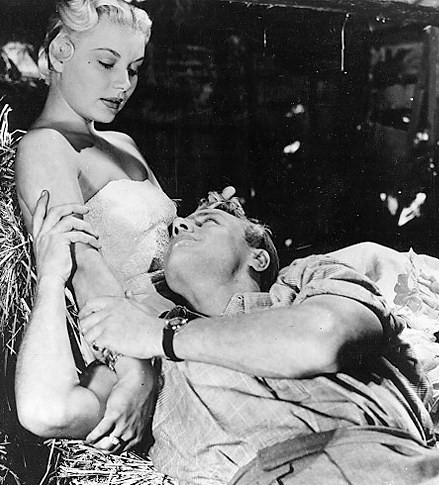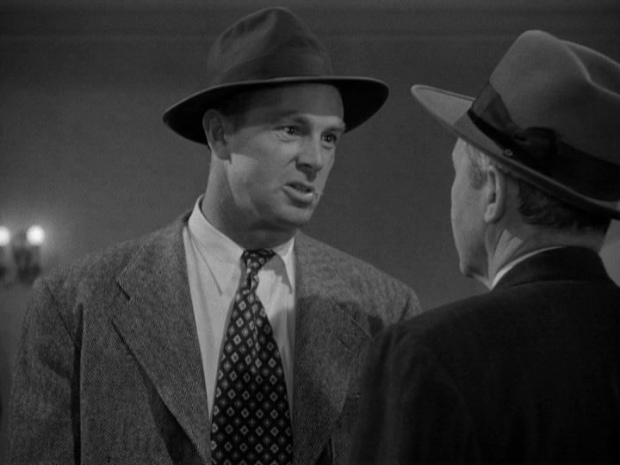
The dramatic methods and strategies of a police procedural film, and
what might be called the moral climate, are quite different from those found in a classic film noir
— a proposition that can be demonstrated by taking a look at films
which try to combine the two forms.
As a case in point, consider Trapped,
starring Lloyd Bridges and doomed starlet Barbara Payton. Bridges
and Payton play a counterfeiter and his moll. The counterfeiter
gets a chance to redeem himself by co-operating with Treasury agents
but is sucked back into his old ways and hurtled toward ruin. We
identify with Bridges in the role because he has an appealing screen
persona and because he's the star, which should be enough to place the
film squarely in the noir tradition.
The filmmakers, however, have chosen to place the Bridges character and his story inside a docu-noir
celebrating the Treasury department, its agents and procedures. John Hoyt,
who usually plays villains, is the chief Treasury operative, acting
undercover. The narrative encourages us to root for him — the
casting makes this all but impossible.
This might at first seem like an interesting formula, producing a
complex tension between the two narrative traditions, but it all falls
apart in the final reel, because the filmmakers eventually have to
choose which tradition to favor when constructing the climax.
What they do is simply eliminate the Bridges character from the final
action sequence and ask us to identify totally with the agency and its chief
representative. The denouement therefore has no punch, since it
doesn't involve or impact the character we've been previously encouraged to identify most closely with.
Crime Wave is another conflicted noir
with a slightly different dynamic. It starts as a straight-ahead
procedural, with
Sterling Hayden as a police officer trying to hunt down some escaped
cons who've killed a cop in the course of a bungled robbery. The
film veers into noir
territory when it switches focus and concentrates on a character played
by Gene Nelson, an innocent ex-con who gets caught up in the
case. (We know that the Nelson character is a co-equal
protagonist with the Hayden character because he's hooked up with the
very vexing female lead, Phyllis Kirk.)

This is when things start to get interesting, because after we switch our attention to Nelson the Hayden
character, delightfully brutal and pig-headed but undeniably
charismatic, starts making mistakes, mistakes that plunge the Nelson
character deeper into his vortex of doom. It takes some narrative
sleight-of-hand at the end of the film to redeem Hayden's cop,
and the police, who become the agents of the Nelson character's
salvation, thus restoring the pro-police bias of a procedural. (The sleight-of-hand involves a classic film noir
heist-gone-wrong which turns out to have been not exactly what it
seemed to be — in other words, a bit of a cheat, though still
entertaining.)
This film does manage to have it both ways, after a fashion, but the core of it is noir,
because we spend so much of the time out of sympathy with the
police. The cop and the innocent-man-wrongly-accused both seem
trapped in a hopeless and bewildering moral maze.
I think you can call Crime Wave a true noir. Trapped is so schizophrenic that it's simply unclassifiable.
